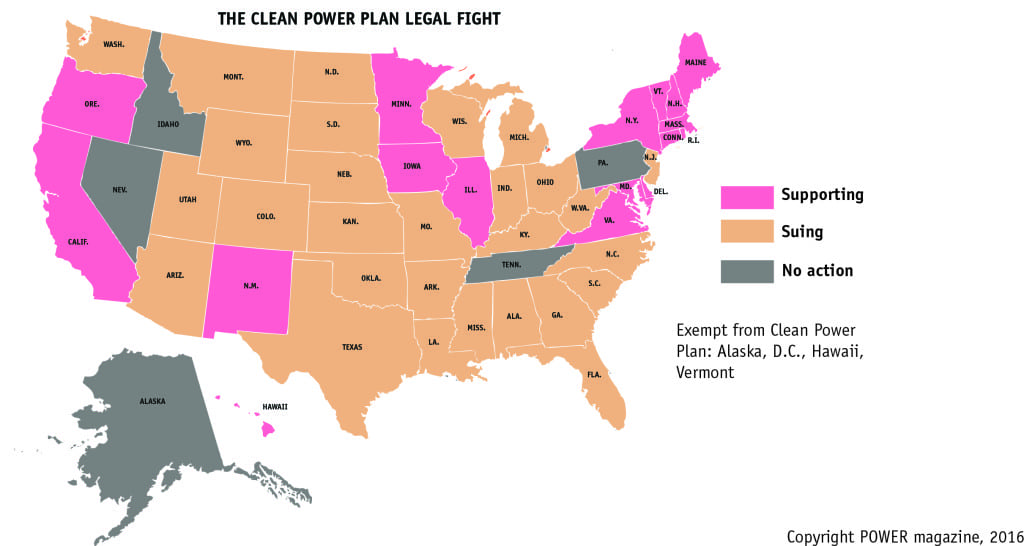In two separate actions over the past 24 hours, the D.C. Circuit granted the Environmental Protection Agency’s (EPA’s) request to suspend cases challenging the Clean Power Plan and the Mercury and Air Toxics Standards (MATS).
The orders are the latest in a series of similar actions over the past month by the D.C. Circuit that paused other major cases challenging Obama-era environmental rules to give the Trump administration more time to review them.
On April 11, the court granted the EPA’s motion to indefinitely delay a decision on challenges to the agency’s 2015 National Ambient Air Quality Standards (NAAQS) for ozone in Murray Energy Corp. v. EPA (No. 15-1385). On April 24, it shelved oral arguments in challenges to the EPA’s rule that requires 36 states to revise emissions exemptions in their state implementation plans for startup, shutdown, and malfunction events at power plants and other facilities. That case, Walter Coke, Inc., et al v. EPA (No. 15-1166), may be reopened depending on the action the EPA decides to take.
On April 27, the court granted the EPA’s April 18 motion to delay oral arguments scheduled on May 18 for litigation filed by an assortment of coal producing and generating companies, which are challenging the agency’s “Supplemental Finding That It Is Appropriate and Necessary To Regulate Hazardous Air Pollutants From Coal- and Oil-Fired Electric Utility Steam Generating Units.” The EPA had urged the court to grant the delay so it could review the Obama administration’s final cost consideration for its MATS rule to determine whether it should reconsider the rule or some part of it.
And on April 28, in what many consider a final blow to the Obama administration’s legacy Clean Power Plan, the D.C. Circuit issued a two-page order granting a 60-day stay of the case. It also ordered the EPA to file status reports at 30-day intervals starting next month, and it requires parties to the litigation to file supplemental briefs addressing whether the consolidated cases should be remanded to the EPA rather than held in abeyance.
A Death Blow to the Clean Power Plan
The D.C. Circuit Court of Appeals heard oral arguments in the case, State of West Virginia, et al v. EPA, et al (No. 15-1363), before an en banc panel on merits of the EPA’s controversial Clean Power Plan on September 27, 2016. However, as industry experts have widely noted, the federal court is not obligated to issue a decision in the case, and many agreed that the length of time that has elapsed since the oral arguments concluded is an indication that it might never do so.
The rule, which imposed the first-ever federal limits on carbon emissions from power plants across the nation when it was finalized in August 2015, had already been stayed by the U.S. Supreme Court on February 9, 2016. Then on March 28, President Donald Trump, who vowed to decimate the rule on the campaign trail, signed an executive order, rescinding a substantial number of key provisions outlined by the previous administration’s climate agenda and directing a review of some rules that may place costly burdens on coal generators, coal miners, and oil and gas producers. A key measure called on the EPA to begin a reevaluation of the Clean Power Plan and the New Source Performance Standards.
Hours after Trump signed the executive order, the EPA announced it had initiated a review of the rule. Nearly as immediately, the Justice Department asked the D.C. Circuit to hold the consolidated cases in abeyance until the EPA can fully review the rule and respond to the president’s executive order. Justice Department lawyers argued that “such abeyance will promote judicial economy by avoiding unnecessary adjudication and will support the integrity of the administrative process.”
A coalition of 24 states and localities, as well as environmental groups and power companies that are backing the Clean Power Plan earlier this month urged the D.C. Circuit to reject the EPA’s motion and act to resolve “critical live disputes over the scope” of the plan, arguing the federal court’s decision was necessary.
But on Friday, an order issued by nine D.C. Circuit judges (Chief Judge Merrick Garland did not participate) swung in the EPA’s favor, stalling the litigation until the EPA could work through the process of repealing the rule.
“This is obviously important but not terribly surprising,” said Jeff Holmstead, who is a partner with law firm Bracewell LLP and a former EPA air administrator, in a statement on April 28.
“I don’t think the D.C. Circuit has ever gone ahead and decided on the legality of a rule when a new administration says it plans to rescind or revise it. The only question now is whether the case will be held in abeyance or remanded back to EPA. If the Court had upheld the rule, it wouldn’t have prevented the new Administration from revoking it, but it might have made this effort harder.”
At the very least, Holmstead said, the D.C. Court’s order today means that “it will not take as long for the Administration to undo the Clean Power Plan.”
MATS in Limbo
The D.C. Circuit’s order on Thursday in Murray Energy Corporation v. EPA, et al. (No.16-1127) indefinitely suspends the case that consolidates six appeals challenging the EPA’s supplemental finding, which the agency issued a year ago after a divided Supreme Court in June 2015 (in Michigan v. EPA) told the EPA it must consider costs in an “appropriate and necessary” finding that bolsters MATS.
The supplemental finding essentially finds that public benefits offered by MATS far outweigh costs.
MATS, finalized in February 2012, required all U.S. coal- and oil-fired power plants with a capacity of 25 MW or more to deploy pollution controls to curb emissions of mercury and other air pollutants such as arsenic and cyanide within three years. Nearly two years after the high court’s decision, almost all regulated entities have taken some action to comply with the rule.
In its April 18 motion to delay oral arguments in the case challenging the supplemental finding, the EPA said it needed more time as it “intends to closely review the Supplemental Finding, and the prior positions taken by the Agency with respect to the Supplemental Finding may not necessarily reflect its ultimate conclusions after that review is complete.”
While the EPA did not respond to POWER‘s request for data on how many plants have yet to comply with the rule—nor to questions about how a reconsideration of the finding would affect power plants that have already complied with the rule—an EPA spokesperson last week told POWER that the motion to delay the oral arguments was simply to give it more time.
“Given the broad-reaching economic implications of the MATS rule, we are carefully reviewing the Agency’s consideration of the costs of the rule to determine whether it is in line with the pro-jobs, pro-growth directives of this Administration,” said EPA spokesperson Liz Bowman on April 20. “We simply request the court grant us additional time to ensure we can continue this thorough and deliberative process.”
As with the Clean Power Plan order, the D.C. Circuit’s MATS order on Thursday will require the EPA to file status reports on the agency’s review of the supplemental finding at 90-day intervals starting at the end of July.
—Sonal Patel is a POWER associate editor (@sonalcpatel, @POWERmagazine)











